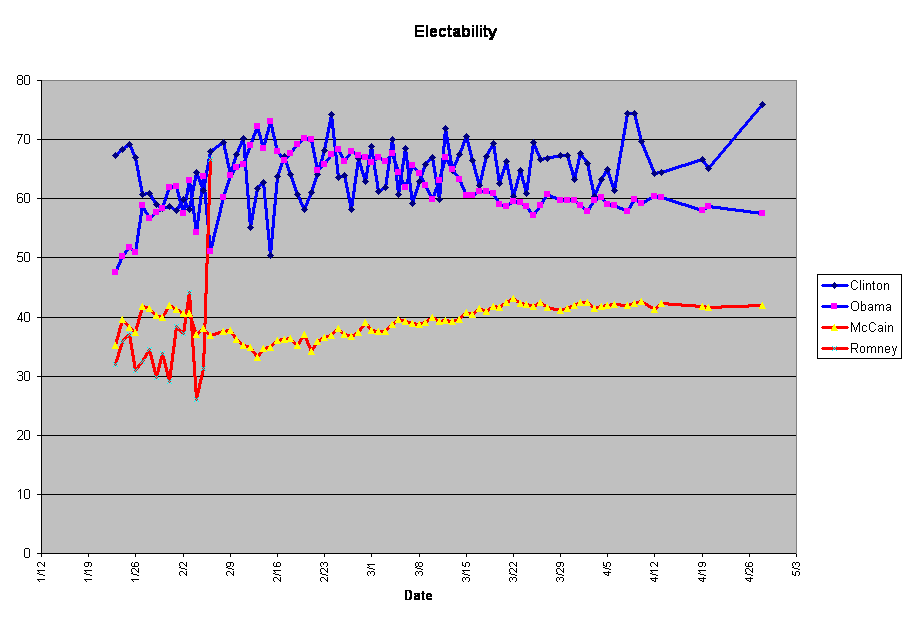Here’s the latest data on the electability of the Democratic presidential candidates, as determined by the political futures market Intrade.
Probability of getting nomination Probability of winning election Electability
Clinton 17.1% 13% 76%
Obama 80.1% 46% 57.4%
Remember that electability is defined to be the probability that a candidate wins the election, given that the candidate gets the nomination. Intrade lets people bet on which candidate will get the nomination and on which candidate will win the election. In both cases, the odds can be interpreted as probabilities, which are the numbers listed above. The ratio of the probabilities, by Bayes’s Theorem, is the electability.
At the bottom of this post I’ll put a graph showing electability over time. The market “thinks” that Clinton is significantly more electable than Obama, and it has thought so pretty much all the time for the past couple of months.
From conversations with various people it’s become clear that I should be more explicit about what it even means to say what the market thinks a candidate’s electability is. Here’s one way to put it: If you think that Obama’s electability is significantly different from the above value, then you can place bets on Intrade whose odds favor you, and similarly for Clinton. After the page break below, I’ll give excruciatingly explicit details about how you’d place these bets.
Lots of people are confident that the futures market has gotten this wrong — in particular, partisans of each of the two Democrats seem to think that the other one’s electability is very low. A natural question to ask these people is this: have you put your money where your mouth is?
OK. Here’s the electability graph. Data were taken from Slate’s Political Futures pages on every day when I remembered to do it.
Here’s an example of the bets you should place if you think the market’s got the electability wrong. Suppose you think that Obama’s electability is much lower than the market value. (Let me be clear: This is just an example, not necessarily what I think. You could run the numbers for his electability being higher than market value, or for Clinton’s numbers.) There are a couple of different ways you can place bets on Intrade to take advantage of this. First of all, if you believe this, then you must believe that Intrade has gotten one of the other probabilities wrong: either his probability of getting the nomination is higher than Intrade thinks, or his probability of winning the election is lower. If you think that you know which one it is, then you just place a bet on that market.
But suppose you don’t know which one it is: you’re sure his electability is low, but you’re not willing to say what those two individual probabilities are. Then you can place a bet where you break even if he doesn’t get the nomination, you win if he gets the nomination but loses the election, and you lose if he goes all the way. Intrade is currently saying that Obama has an 80% chance of winning the nomination and a 46% chance of being president, leading to an electability of 46/80 = 57.5%. Say you bet $1000 on him to win the nomination. To hedge your bets, you place a bet against him to win the Presidency, with the amount chosen to win you $1000 in that event. If I’ve done the arithmetic right, a bet of $1170 will do the trick. Suppose that he loses the nomination. You win the second bet, with a payoff of $1170/ (1-0.46) =$2170, for a net profit of $1000, offsetting your $1000 loss on the first bet.
With these bets, you end up coming out $1250 ahead if he wins the nomination but loses the election, and $924 behind if he goes all the way. These are favorable odds (that is, you stand to make a net profit) as long as you believe his electability is less than 1250/(1250+924)=57.5%.
Of course, I haven’t included the opportunity cost of having your money tied up in these bets while the election plays out. In the event that he doesn’t get the nomination, you’ve invested your money for several months at 0% return. You should probably tweak the numbers a bit to build in a decent rate of return in that case. If you raise your bet against him going all the way to $1250, say, then you end up netting a 3% return on your investment in the event that he doesn’t win the nomination. That drives down your return in the case where he goes all the way, of course, but if you run the numbers you still come out ahead as long as his actual electability is significantly less than the market value.
To repeat, I’m using the case of Obama’s electability being low as just an example. The same sort of thing works if you think his electability is high, or if you think Clinton’s electability is wrong in either direction too. At least, that’s true in principle. Because Clinton’s probability of getting the nomination is seen as low, the opportunity cost of tying up your money in bets on her electability is higher: there’s a greater chance that your bets will just break even. As a consequence, if you try to build in a decent rate of return on your investment in that case, it costs you more. So in practice it’s harder to bet on Clinton’s electability at the moment than on Obama’s.
